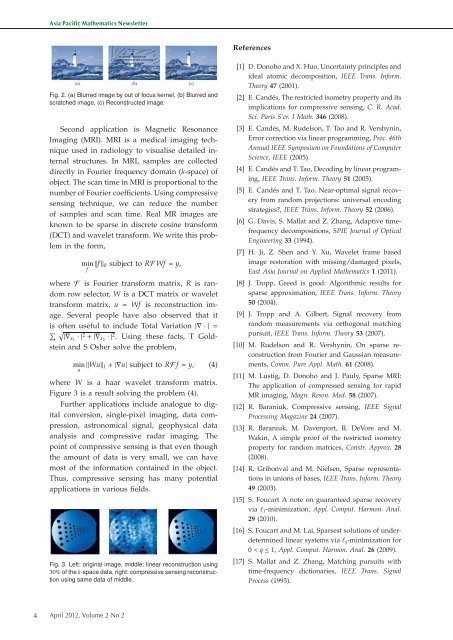Mathematics Newsletter
Mathematics Newsletter
Mathematics Newsletter
Create successful ePaper yourself
Turn your PDF publications into a flip-book with our unique Google optimized e-Paper software.
4<br />
Asia Pacific <strong>Mathematics</strong> <strong>Newsletter</strong><br />
Fig. 2. (a) Blurred image by out of focus kernel, (b) Blurred and<br />
scratched image, (c) Reconstructed image.<br />
Second application is Magnetic Resonance<br />
Imaging (MRI). MRI is a medical imaging technique<br />
used in radiology to visualise detailed internal<br />
structures. In MRI, samples are collected<br />
directly in Fourier frequency domain (k-space) of<br />
object. The scan time in MRI is proportional to the<br />
number of Fourier coefficients. Using compressive<br />
sensing technique, we can reduce the number<br />
of samples and scan time. Real MR images are<br />
known to be sparse in discrete cosine transform<br />
(DCT) and wavelet transform. We write this problem<br />
in the form,<br />
min ||f ||0 subject to RF Wf = y,<br />
f<br />
where F is Fourier transform matrix, R is random<br />
row selector, W is a DCT matrix or wavelet<br />
transform matrix, u = Wf is reconstruction image.<br />
Several people have also observed that it<br />
is often useful to include Total Variation |∇·| =<br />
� �<br />
|∇x1 ·|2 + |∇x2 ·|2 . Using these facts, T Goldstein<br />
and S Osher solve the problem,<br />
min<br />
u ||Wu||1 + |∇u| subject to RF f = y, (4)<br />
where W is a haar wavelet transform matrix.<br />
Figure 3 is a result solving the problem (4).<br />
Further applications include analogue to digital<br />
conversion, single-pixel imaging, data compression,<br />
astronomical signal, geophysical data<br />
analysis and compressive radar imaging. The<br />
point of compressive sensing is that even though<br />
the amount of data is very small, we can have<br />
most of the information contained in the object.<br />
Thus, compressive sensing has many potential<br />
applications in various fields.<br />
Fig. 3. Left: original image, middle: linear reconstruction using<br />
30% of the k-space data, right: compressive sensing reconstruction<br />
using same data of middle.<br />
April 2012, Volume 2 No 2<br />
References<br />
[1] D. Donoho and X. Huo, Uncertainty principles and<br />
ideal atomic decomposition, IEEE Trans. Inform.<br />
Theory 47 (2001).<br />
[2] E. Candés, The restricted isometry property and its<br />
implications for compressive sensing, C. R. Acad.<br />
Sci. Paris S’er. I Math. 346 (2008).<br />
[3] E. Candés, M. Rudelson, T. Tao and R. Vershynin,<br />
Error correction via linear programming, Proc. 46th<br />
Annual IEEE Symposium on Foundations of Computer<br />
Science, IEEE (2005).<br />
[4] E. Candés and T. Tao, Decoding by linear programing,<br />
IEEE Trans. Inform. Theory 51 (2005).<br />
[5] E. Candés and T. Tao, Near-optimal signal recovery<br />
from random projections: universal encoding<br />
strategies?, IEEE Trans. Inform. Theory 52 (2006).<br />
[6] G. Davis, S. Mallat and Z. Zhang, Adaptive timefrequency<br />
decompositions, SPIE Journal of Optical<br />
Engineering 33 (1994).<br />
[7] H. Ji, Z. Shen and Y. Xu, Wavelet frame based<br />
image restoration with missing/damaged pixels,<br />
East Asia Journal on Applied <strong>Mathematics</strong> 1 (2011).<br />
[8] J. Tropp, Greed is good: Algorithmic results for<br />
sparse approximation, IEEE Trans. Inform. Theory<br />
50 (2004).<br />
[9] J. Tropp and A. Gilbert, Signal recovery from<br />
random measurements via orthogonal matching<br />
pursuit, IEEE Trans. Inform. Theory 53 (2007).<br />
[10] M. Rudelson and R. Vershynin, On sparse reconstruction<br />
from Fourier and Gaussian measurements,<br />
Comm. Pure Appl. Math. 61 (2008).<br />
[11] M. Lustig, D. Donoho and J. Pauly, Sparse MRI:<br />
The application of compressed sensing for rapid<br />
MR imaging, Magn. Reson. Med. 58 (2007).<br />
[12] R. Baraniuk, Compressive sensing, IEEE Signal<br />
Processing Magazine 24 (2007).<br />
[13] R. Baraniuk, M. Davenport, R. DeVore and M.<br />
Wakin, A simple proof of the restricted isometry<br />
property for random matrices, Constr. Approx. 28<br />
(2008).<br />
[14] R. Gribonval and M. Nielsen, Sparse representations<br />
in unions of bases, IEEE Trans. Inform. Theory<br />
49 (2003).<br />
[15] S. Foucart A note on guaranteed sparse recovery<br />
via ℓ1-minimization, Appl. Comput. Harmon. Anal.<br />
29 (2010).<br />
[16] S. Foucart and M. Lai, Sparsest solutions of underdetermined<br />
linear systems via ℓq-minimization for<br />
0 < q ≤ 1, Appl. Comput. Harmon. Anal. 26 (2009).<br />
[17] S. Mallat and Z. Zhang, Matching pursuits with<br />
time-frequency dictionaries, IEEE Trans. Signal<br />
Process (1993).<br />
4


